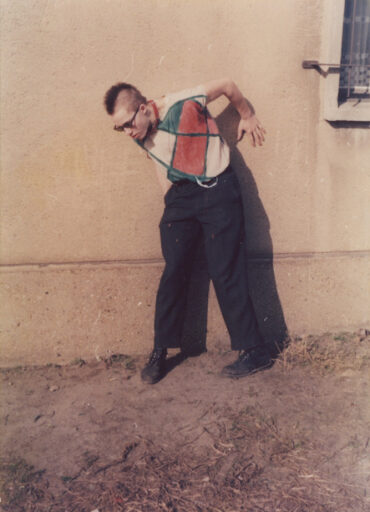
Protest!? Wir haben die Wahl

Various & Gould, o. T., aus der Serie: Identikit, 2016, Foto: Rainer Weisflog, Cottbus 2016, bearbeitet
Hinweis: Die Ausstellung wurde verlängert und endet nun am So 1.12.2024
Bruno Barbey, Paul Fusco, Guerilla Girls, Harald Hirsch, Oskar Nerlinger, Martin Parr, Ludwig Rauch, Jens Rötzsch, Gundula Schulze Eldowy, David Seymour, Various & Gould, Karl Völker
Im Zentrum der präsentierten Druckgrafiken, Fotografien und Installationen stehen nicht die Gründe und Bedingungen, die zu unterschiedlichen Formen des gesellschaftlich und politisch relevanten Protestes geführt haben (oder führen). Vielmehr zielen die Kunstwerke darauf ab, die Präsenz von Protesten und Revolutionsansätzen in öffentlichen Sphären, meist dem urbanen Raum, zu beschreiben, abzubilden und zu kommentieren, beizeiten auch zu unterstützen.
Thematisiert werden daher reale, gesellschaftspolitische Proteste in den 1920er und 1930er Jahren, Phänomene der künstlerischen Reflexion von Protestbewegungen, Kundgebungen im Arbeiter- und Studierendenmilieu der 1960er Jahre sowie feministische Positionierungen im Kunstbetrieb. Darüber hinaus sind auch die Demonstrationen, die zum Zusammenbruch der DDR geführt haben in der Ausstellung präsent. Ein weiteres Augenmerk liegt auf der Transformation von historischen Bildern durch beispielsweise Entkontextualisierung und Ökonomisierung. Als Grundlage für die Werkauswahl dient die Sammlung des BLMK und viele der gezeigten Arbeiten sind jeweils in der Zeit entstanden, die sie gleichermaßen dokumentieren. Somit sind sie in ihrer künstlerischen Form gleichzeitig auch historische, kulturgeschichtliche Zeugnisse.
…
The exhibition is dedicated to artistic reflections on the visibility of various protest movements of the 20th century. The focus of the prints, photographs and installations presented is not on the reasons and conditions that have led (or lead) to various forms of socially and politically relevant protest. Rather, the works of art aim to describe, depict and comment on the presence of protests and revolutionary approaches in public spheres, mostly urban space, and at times also to support them.
The thematization therefore includes real, socio-political protests in the 1920s and 1930s, phenomena of artistic reflection of protest movements, rallies in the working-class and student milieu of the 1960s and feminist positions in the art world. In addition, the demonstrations that led to the collapse of the GDR are also present in the exhibition. Another focus is on the transformation of historical images through, for example, decontextualization and economization. The BLMK collection serves as the basis for the selection of works and many of the works shown were created in the period that they equally document. Thus, in their artistic form they are simultaneously historical, cultural-historical testimonies.







